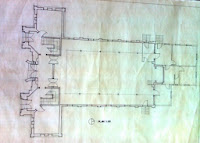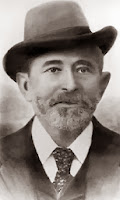 |
| The Old Jewish Synagogue after its completion |
Significance
The Old Jewish Synagogue is situated in the CBD of Pretoria.
The synagogue plays a part in the history of Pretoria. It is the first
Synagogue that was erected in Pretoria but its function as a synagogue changed
with the country’s political changes. It was converted to the High Court where
numerous high profile hearings and court cases, involving amongst others Nelson
Mandela and Steve Biko, took place.
History
 In the late 1840’s, Adolf Coqui was the first Jewish settler
in Pretoria. From here on, the Jewish community started to grow in Pretoria. As
time went on, the need for a space to be available to perform services was
needed. Prior to this, private homes, hotels, and halls were used to hold
services which were performed by a layman. The Caledonian hall opened its doors
to the Jewish community to hold their services in 1891-1892. But the hall was
also used for private banquets ad other balls and functions. The Jewish
community felt that it was not appropriate to hold religious services at this
venue.
In the late 1840’s, Adolf Coqui was the first Jewish settler
in Pretoria. From here on, the Jewish community started to grow in Pretoria. As
time went on, the need for a space to be available to perform services was
needed. Prior to this, private homes, hotels, and halls were used to hold
services which were performed by a layman. The Caledonian hall opened its doors
to the Jewish community to hold their services in 1891-1892. But the hall was
also used for private banquets ad other balls and functions. The Jewish
community felt that it was not appropriate to hold religious services at this
venue.
The Jewish community formed a congregation and it was
decided that there was a need for their own synagogue in Pretoria. On the 11th
December 1895, Simon Eeinbergand and Herman Manneschwitz bought Erf 103 from
Thomas Patterson for the local Jewish community for £1500.
 |
| Floor plan |
On the 1st October 1897, architects, Ilber and Beardwood
were commissioned to design the synagogue in a Byzantine manner. The building’s
budget was not to exceed £5000. But as any project, the budget escalated and
was slightly less than £6000 even though Samuel Marks donated electrical
lighting fixtures for £300 as well as the bricks for the project. We can also
note that the Jewish congregation ran into more financial difficulties because
the street facade is the only facade that has the Byzantine theme. The other
elevations do not carry on the same theme. Face brick and sandstone detailing
was omitted due to the cost and a cheaper alternative was to use cheap bricks
and plaster on the facades of the building, but even through the financial
difficulties the Synagogue opened its doors to the public on the 20th August
1898.
This was not the end to the congregation’s financial
difficulties. They had to raise a further £850 by the end of 1898 to pay the
contractor and builder. But thankfully to the generous help of Sammy Marks, he
donated the amount to the Jewish congregation. But this did not help in future
months to come. The congregation could only renew the minister’s contract on a
monthly basis because funds were scarce. Sammy Marks
again came to the Jewish
community’s aid in 1901 when money was needed to repair and maintain the
building, but it was not the end. In 1906 on the 9th September the congregation
had to apply for an overdraft of £1500 and could only do so if the synagogue
was mortgaged. Sammy Marks attorneys advised him to buy the property from the
congregation and donate it back to them, subject to registration of certain
conditions. 21st October 1906 must have been the most important day in the
Jewish community’s history. A general meeting was held where trustees of the
Jewish congregation authorised the sale to the astute Mr Sammy Marks (Samuel
Marks) for the mortgage bond amount of £4000. The transfer would be given
immediately over to the Jewish congregation with the certain binding
limitations. These limitations were:
 |
| Sammy Marks |
- The property may not be sold, ceded or assigned to anyone, but is to be used exclusively for Synagogue purposes in perpetuity;
- That no mortgages, charges or other encumbrances be put on , applied to or laid upon the property under any circumstances;
- That the house on the property be used solely as the residence of the Minister of the Congregation or alternatively by some official of the Synagogue.
 |
| Inside the synagogue |
On Sunday 7th August 1907, Sammy Marks formally handed over
the title deeds of the synagogue together with three fire insurance policies to
the Pretoria Jewish congregation.
In 1922 the congregation decided that the synagogue was to
small and that additions and alterations. They sent in a request to overturn
the conditions that were set by Sammy Marks to register the property to apply
for a mortgage. The Supreme Court declined this request because the donation
was only made a few years previously.
The old synagogue becomes the new Pretoria Supreme Court
During the Apartheid era, the black resistance against the
government was building. The black resistance was mostly verbal and
non-violent. Black leadership became more visible and outspoken and there was
an increase in strikes and passive resistance. In view of the deteriorating
situation, the government decided that there was a need for a special supreme
court. The government needed a building that allowed for relatively large
numbers for people to observe, interested parties and defendants. Also they
needed a building that would have to be located in an area which was manageable
in terms of security and effective crowd dispersal. The old synagogue was
identified to be the new Pretoria Supreme Court.
The changes that were made to the building to make it an
effective court were:
 |
| The synagogue with its cream paint finish and window above the front door removed |
- Painting the facades and brick work in cream colour.
- The removal and bricking up of the stained glass.
- The removal and replacement of all the timber top hung window on both the northern and southern facades.
- The alteration of the altar stage into judge benches.
- The addition of judge chambers, toilet and ante rooms on the eastern side of the synagogue.
- The keying and plastering of the original sandstone plinth which was deteriorated.
- Application of acoustic board to a large percentage of the internal walls.
- The addition of separate structures outside the main synagogue.
 |
| Nelson Mandela, Aziz Pahadand Winnie Mandela outside the Old Synagogue |
The main trials that were seen at the Supreme Court. The
treason trial was one of the longest trials in South African history. All the
accused were either members of the ANC or Black Consciousness movements. Nelson
Mandela was one of the accused members. The Steve Biko inquest was heard at the
Supreme Court. The Sharpville and Langa Incidents were both heard in the court.
Nelson Mandela was tried in 1962 and was initially sentenced to 5 years hard
labour. During the Rivoina Trial he was sentenced to life in prison with hard
labour.
Reproduced from The Universiy of Ptretoria's 'Ablewiki' and various various other sources























